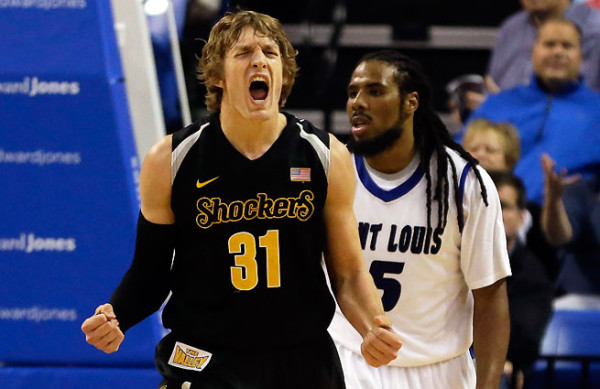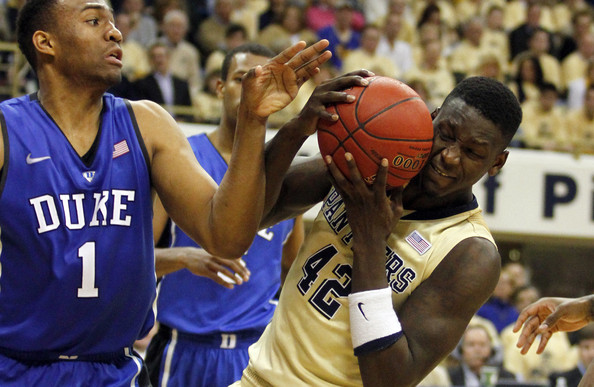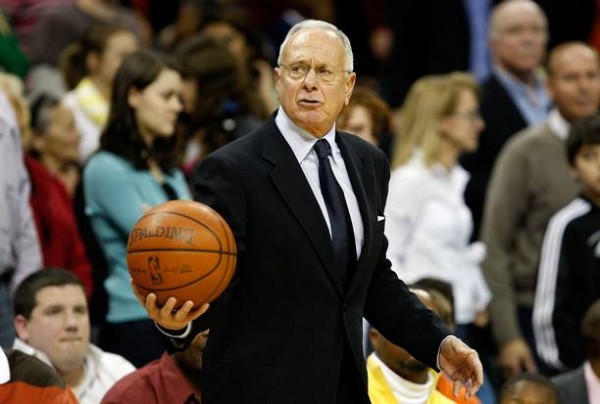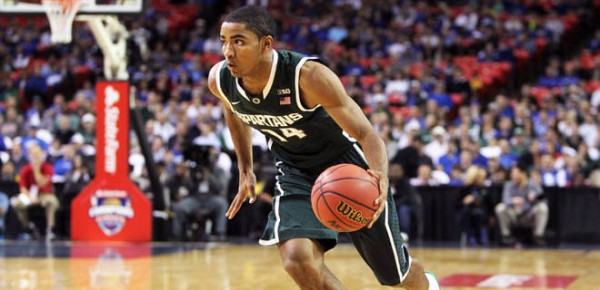Bracket Prep: On Wichita’s Draw, the Loaded South and Non-Conference SOS…
Posted by Chris Johnson on March 17th, 2014At this point, you’ve probably filled out at least five brackets and torn up a few more. There are some match-ups you can’t wait to see and others you’re not so psyched about. There are trendy upset possibilities you agree with and some you’re staying away from precisely because everyone else seems to be leaning that way. You feel good about two of your four Final Four picks; the other two are toss-ups. If you filled out multiple brackets, there may be 16 teams about which you’ve casually tell your friends and co-workers, “I have them in the Final Four.” Me? I filled out one bracket, but I’m not here today to reveal my picks. That’d be more embarrassing than anything else; over the years I’ve come to learn a painful lesson: Watching and write about college hoops doesn’t make you any more likely to win your bracket pool than your football-obsessed friend who’s taken in two full games all season. What you see below are simply the first four thoughts that coalesced in my mind after I printed and scanned this year’s bracket for the first time, mere minutes after the selection show.
Did Wichita State Really Get ‘Screwed’?
The reaction to Wichita State’s placement in the Midwest region with #2 Michigan, #3 Duke, #4 Louisville and #8 Kentucky was nearly unanimous: The Shockers are toast. This sentiment is understandable. Duke and Michigan are incredibly tough to guard; both rank in the top three in the country in points scored per possession. Louisville ranks second in Ken Pomeroy’s team ratings and has won 12 of its last 13 games, seemingly peaking at the perfect time. And in three SEC Tournament games, Kentucky more closely resembled the juggernaut we all predicted in the preseason – wrongfully, might I add – that would reach the Final Four. None of those teams will be easy to beat. This is a tough region; I’m not disputing that. Wichita State will have its hands full, for sure. But saying Wichita State got ‘screwed,’ or even that it faces a much tougher road to Arlington than, say, Florida, is a bit of a stretch, if you ask me. The most arduous path the Shockers could face is the following: Kentucky in the round of 32, Louisville in the Sweet Sixteen, and Duke in the Elite Eight. The only game out of those three I wouldn’t take Wichita State in is against Louisville, and that one would be a toss-up.
Did we all forget that Duke nearly lost to Clemson less than a week ago; or that Kentucky lost to South Carolina earlier this month; or that Louisville was swept by Memphis? These teams are seeded where they are because that’s what their performance over 30-plus games dictated. Wichita State was dominant from November to March (save that away game at Missouri State in early January). It is one of two teams in the country that ranks in the top 10 of Pomeroy’s offensive and defensive efficiency. Whereas the other teams in this region have stumbled at various junctures, the Shockers destroyed practically everyone they played. Does that mean Wichita won’t have to fight for an invitation to the Final Four? No. It’s just a reminder that, when evaluating teams, take into account what you saw over the course of the entire season. The sample size we use to assess college basketball teams is small enough; 30 or so games are not a lot of data. But the Shockers were utterly dominant over those 30 or so games. The other teams in this region were not. And for the sake of comparison…
The South is Loaded
Florida is the No. 1 overall seed, and rightfully so. Had the Gators been healthy the entire season – specifically, in November and December, when it lost to Wisconsin and UConn, respectively – they might have gone undefeated. This is a really good team with the type of coach we like to call an excellent ‘Tournament Coach.’ Which is to say, Billy Donovan is not Josh Pastner. But look at the teams Florida might need to beat to reach the Final Four. #8 Pittsburgh’s recent track record is spotty – the Panthers haven’t advanced past the round of 32 in three tourney appearances since 2009. Still, Pitt is one of those teams for whom a massive gulf exists between win/loss-based resumé and per-possession performance. Jamie Dixon’s team lost a bunch of close games this season, but it also ranks in the nation’s top 40 in offensive and defensive efficiency, excels at rebounding its own misses, and gets to the free throw line at a high rate. Pittsburgh is the Iowa you didn’t hear about, the team that got close to pulling out a big win so many times you almost became numb to it.
Then there’s #5 VCU. Preparing for Shaka Smart’s trademark HAVOC defense is an immense task on its own. Actually executing – protecting the ball; preventing runouts; getting into half-court sets – is another matter entirely. Did we forget that the Rams are pretty good at this Tournament thing, too? I recall a certain controversial #11 seed beating #6 seed Georgetown (which, ok, everybody does that), #3 seed Purdue and #1 seed Kansas en route to the Final Four. There’s also #4 UCLA, which in beating Arizona in the Pac-12 Tournament championship, seems to be hitting its stride at just the right moment, and #7 New Mexico, which in recent weeks has looked better than Mountain West regular season champion and San Diego State*. And that’s without mentioning two other teams that, at various points of the season, looked as if they’d earn #1 seeds: #3 Syracuse and #2 Kansas. Florida is the best team in the field. Few people would dispute that. But to make good on that designation – one formalized by the committee’s decision to rank Florida No. 1 on its official seed list – the Gators will have to navigate what is, top to bottom, the toughest region in the field.
*I realize this analysis comes off as hypocritical, given my comments about Wichita State’s competition in the Midwest region. I have no counter. Just play along.
Strength of Schedule is a Big Deal
One of the first four teams left out of the field was Southern Methodist. Most of the mocks had the Mustangs in the field (Patrick Stevens of Syracuse.com, I salute you). SMU was a disappointing omission. An NCAA Tournament berth would have been a nice reward for all the good work Larry Brown has done in such a short time at the helm of a once-forlorn program. Looking at the Mustangs’ resumé, it’s hard to muster up too much outrage over the committee’s decision. In recent years the committee has stressed the importance of non-conference strength of schedule. Were SMU to make the field, its 303rd-ranked non-conference schedule would have been the lowest any team seeded #9 through #16 has received since Air Force in 2006, according to Stevens. SMU won three games against teams ranked in the top 25 of the RPI and had a respectable RPI of #52, but in the committee’s view, the more favorable aspects of the Mustangs’ profile didn’t outweigh their prohibitive schedule. In a conference call on Sunday night, committee chairman Ron Wellman explained why SMU was exluded. “In SMU’s case, their downfall, their weakness, was their schedule,” he said. “Their non-conference strength of schedule was ranked 302nd. It was one of the worst non-conference strength of schedules. Their overall strength of schedule ranked #129. That would have been, by far, the worst at-large strength of schedule going into the tournament. The next worst at large strength of schedule was #91. Really, the glaring weakness about SMU was their schedule.”
That should send a message to coaches of at-large teams considering loading up on patsies in November and December. If you want to make the NCAA Tournament, you have to play good teams. In the process, you’ll probably lose a few more games than you would have had you crafted a soft schedule. But while the committee values good wins in the non-conference, it also looks favorably upon teams that play tough schedules – even if they suffer a few losses along the way. Here’s another indication of the sway non-conference scheduling has on the committee’s thinking. BYU, a team plenty of mocks projected to be slotted into the First Four, was awarded a No. 10 seed. Not only did the Cougars suffer a slew of bad losses in conference play – Pacific, Pepperdine, Portland, Loyola Marymount – it lost one of its best players, forward Kyle Collinsworth, for the season to injury less than a week before selection Sunday. Explaining the gap between the mocks’ consensus projection of BYU and the committee’s is simple: BYU had the No. 4 non-conference schedule in the country (did the fact BYU can’t play on Sundays factor in here? Probably). Those ugly, sub-100 WCC losses weighed down the Cougars’ profile, to be sure. But the Cougars scheduled up in the non-conference – and really, only have two OK wins (Stanford and Texas) to show for it – and that was enough for the committee to keep them away from the First Four.
These #4 seeds Are Scary
I wouldn’t be surprised if all but one of the #4 seeds emerged from their respective regions and made the Final Four. The oddsmakers have Michigan State at 9-to-2 to win the championship; only Florida, at 4-to-1, has better odds of winning it all. I think Vegas got this right. All season long, people have touted Michigan State’s merits as a potential Final Four team. The one disclaimer? As long as everyone’s healthy. In the Big Ten Tournament championship on Sunday, with its full complement of players available, Sparty steamrolled regular season champion Michigan. Michigan State’s impressive run in the conference tournament doesn’t negate all the ugly results that came before – the Spartans lost seven of their final 12 regular season games, after all. So even though the Spartans, in my mind, are an eye test #1 seed, their resumé had too many holes to warrant that classification. If Michigan State can play to its potential and avoid further injuries, it is one of the best four teams in the country, coached by one of the best NCAA Tournament coaches out there. This is a team no one wants to play right now, and for good reason.
Vegas has Lousville at 15-to-1 to cut down the nets. That seems an underestimation of how good the Cardinals are playing right now. We’ve seen this story before, and we know how it ends. Louisville peaking near the end of the regular season, building up steam for a deep Tourney run. Some were quick to write this team off after Chane Behanan was dismissed and word came down that Kevin Ware would redshirt. But the Cardinals have, somewhat quietly, morphed into a super-efficient, well-rounded club, thanks in large part to two things: 1) Montrezl Harrell’s emergence into one of the best post players in the country; and 2) Russ Smith submitting another All-American-worthy season. As for UCLA, consider this one of those ‘gut’ picks. After watching the Bruins quite a bit over the past week in the Pac-12 Tournament, I’m confident Steve Alford has his team playing better than they have all season. Kyle Anderson is a matchup nightmare, and Jordan Adams suffers, I think, from East Coast denizens not watching most of his games. When the Bruins get going on offense, not even Arizona – the best defensive team in the country by a pretty big margin – can stop them. I won’t mention San Diego State here, because I think the Aztecs are an outlier – the obvious weak link of an otherwise strong batch of #4s. But the #1 seeds grouped in the same regions as Michigan State (Virginia), UCLA (Florida) and Louisville (Wichita State) have reason to be nervous about which teams they might face in the Sweet Sixteen.
The Five Most Intriguing Opening Round Games
- #5 VCU – #12 Stephen F. Austin/#5 Oklahoma – #12 North Dakota State: One of these #5s is going down. Not sure which one – SFA is the chic #5-#12 upset pick, so maybe that’s the way to go. Either way, you’ll wanna be watching when it happens.
- #6 Baylor – #11 Nebraska: Scott Drew’s team is surging right now. The Huskers have a gregarious, witty, endearingly childlike coach who tweets at halftime.
- #7 Connecticut – #10 Saint Joseph’s: Because you can’t afford to miss the end of Shabazz Napier’s career. The Hawks are a tough team with three players you should know about: guard Langston Galloway and forwards Halil Kanacevic and Ronald Roberts.
- #8 Gonzaga – #9 Oklahoma State: A lot of people seem to be picking the Pokes to advance to the Sweet Sixteen, but the Zags have quietly put together a nice season. Don’t expect OSU to roll.
- #7 Oregon- #10 BYU – I like Oregon here. Most people do. Neither team guards well, so this should be a fun one, up in the 70s or 80s.
















































